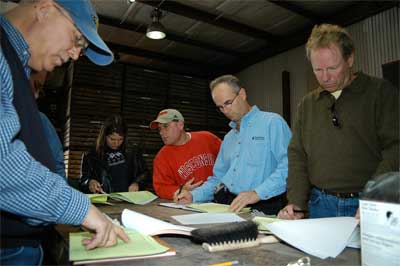Oxnard, California
September 25, 2006
It’s one thing
to evaluate storage onions in the field, but it’s a much
different exercise to take them out of storage and rate them on
the grading line.
|
 |
|
Members of the Eastern sales
team and Stokes evaluate storage onions for
size, scale and storability on the grading line |
|
Each November,
Seminis sales and product development representatives from
the Eastern region travel to the Seminis research station in
DeForest, Wisc. to judge the season’s storage onions for size,
scale and storability and then make recommendations on which
varieties should be advanced.
They are joined by Seminis long day
onion breeder Scott Hendricks and members from Seminis’
Production, Foundation Seed and the Root and Bulb core team.
New and commercial Seminis storage onion
varieties, along with competitive checks, are harvested over the
summer. Three to four bags of onions are taken from each 30-foot
plot. There are four replications and a one-bag sample (60 to 70
pounds) is taken from each to make a representative lot to store
and grade.
“It’s really quite a process,” said Eastern
regional product development manager Paul Lilley. “From each lot
we take 20 onions that are cut for single-centers. The rest of
the lot runs through the grader. Then, the onions are weighed
and, finally, they are put into storage where they will be
evaluated monthly for storability.”
Four varieties appear to have great potential for
the Northeastern United States, and hoping to explore new
territory in the onion market, the varieties have been named
after famous explorers of the Northeast.
|
 |
|
Joe Butwin from Stokes Seeds,
Nancy Ouellet, breeder Scott Hendricks, Jim
Inksetter from Stokes and Tom Hartman prepare to
evaluate storage onions |
|
“I’m really excited about our new explorer
series,” said Ron Garton, the Seminis product development
specialist for New York and Ontario. “Champlain is
early-maturing. Then we move into the main season with
Mackenzie and Cabot and finish the season with
Nicolet. It’s a high quality line-up from start to end.”
Champlain
has 90-day maturity and medium-term storage. It is especially
well-suited for cooler growing areas and muck soils.
Mackenzie has large, round bulbs and excellent uniformity
with 108-day maturity. Cabot is a 110-day onion with a
high yield potential that performs well throughout New York. And
Nicolet has outstanding plant vigor and a strong root
system. With 112-day maturity, it has a high yield potential and
long-term storability.
“There’s more good news on the way,” said
Hendricks. “I’m very excited about several new lines that we’ve
just begun to test. And we have some reds that we’ll see in
first-look trials this year that are a dark purple color and
highly single-centered.”
Like the explorers who first ventured into the
Northeast, the Seminis storage onion program is poised on the
brink of a promising future with a pipeline of new products and
features for onion growers.
Explore the possibilities with storage onions
from Seminis.
Seminis is
the world’s leading developer, producer and marketer of
vegetable seeds. Its products are designed to reduce the need
for agricultural chemicals, increase crop yield, reduce
spoilage, offer longer shelf life, and create better tasting
foods and foods with higher nutritional content. Seminis has
established a worldwide presence and global distribution network
that spans 150 countries and territories. |